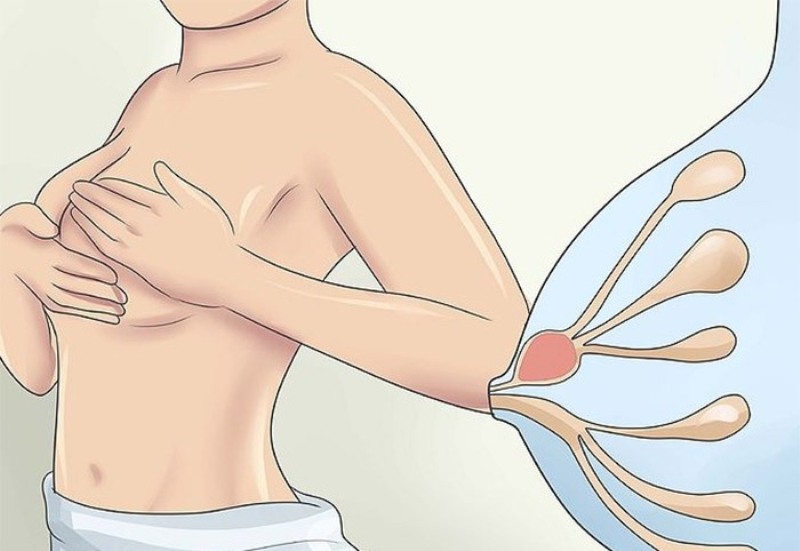After giving birth, many women experience lactostasis. It is characterized by a deterioration in milk production during feeding. Often this leads to serious problems in the newborn and mother.
Knowing what to do with lactostasis, you can start treatment of the pathology as quickly as possible and get rid of it completely. Therapy is carried out medically, as well as using traditional methods.
What is lactostasis?
Lactostasis is a pathology that results in something in the form of a cork in the duct of the mammary gland that interferes with the release of milk. Violation can occur in one or more lobes of the mammary gland.

The milky lobes of the chest are very crowded, and there is a fairly characteristic symptomatology, namely: condensation, tubercles, redness and soreness appear. If treatment is not done in a timely manner, then there is an increase in temperature, severe swelling of the chest. In addition, the pain intensifies very much. To prevent more serious complications, you need to know the causes and symptoms of the disorder, as well as be aware of what to do with lactostasis.
Main reasons
It is important not only to know what to do with lactostasis, but also to understand exactly what reasons can lead to the appearance of a similar problem. The disease cannot develop on its own. The wrong behavior of a young mother and her mistakes when feeding a baby can provoke the occurrence of pathology. Among the most common causes and errors, it is necessary to highlight such as:
- poorly organized feeding;
- rare feeding the baby;
- improperly selected linen;
- lack of decantation;
- chest crush;
- cessation of breastfeeding;
- previous injury;
- fatigue, depression, mental problems;
- structural features of the chest;
- hypothermia.
Women who prefer to sleep on their stomachs also run the risk of having lactostasis. Stagnation of milk appears even if it does not stretch the chest.
Symptoms of Lactostasis
Treatment should be carried out immediately, after the manifestation of the very first signs of lactostasis. In addition, you need to learn how to correctly recognize the symptoms, since they are similar to mastitis, however, there are still characteristic features. Clinical signs of lactostasis are such as:
- discomfort and soreness in the chest;
- pain and bursting on palpation;
- the presence of seals, redness;
- veins expansion and fever;
- malaise.

After identifying signs of a problem, you must definitely determine the tactics of the treatment. It is important to understand exactly what to do with lactostasis, since prolonged stagnation of milk provokes the appearance of mastitis.
What is the difference from mastitis
Quite often, young mothers confuse lactostasis with mastitis and therefore carry out completely incorrect treatment. However, if you carefully examine the existing symptoms, then they can easily be distinguished.
First of all, with mastitis, a very strong inflammation develops, which provokes an almost rapid growth of fibrous tissue, therefore it is not possible to eliminate the swelling of the breast with conventional compresses. If a woman has started lactostasis, then a compress and subsequent pumping will bring significant relief.
That is why, if the chest is swollen, but the lymph nodes are not palpable, then this is lactostasis. While the most pronounced sign of mastitis is the inability to express milk.
Is it possible to feed a baby
When lactostasis appears, it is necessary to ensure maximum emptying of the mammary gland by frequent application of the baby to the chest. This is the most effective method of treating milk stagnation. In addition, it is important to follow certain rules, namely:
- choose the right position for feeding;
- keep your chest warm;
- before applying the baby to the chest, take a warm shower;
- gently massage the breast.

If it is difficult for a child to suckle at the very beginning of feeding, then he needs to express a little milk. To the chest with stasis, the baby is applied first of all and very often. It is also important to establish the optimal feeding regimen.
If abnormalities of the nipples became the cause of lactostasis, then it is recommended to use special pads during breastfeeding.
Features of decanting
Answering the question of what to do with breast lactostasis and how to cope with this problem, we can say for sure that milk must be expressed first. However, you must know how to do it right. Manual pumping allows you to very carefully get rid of the problem. Clogged ducts can be well kneaded with your fingers, which helps to improve the condition. It is necessary to carry out such procedures as often as possible in order to get rid of stagnant milk as soon as possible and to prevent complications. For decanting, you need to place 4 fingers under the nipple, and the thumb on top. Then you need to sort through them, slightly pressing down the chest. This allows you to massage and remove stagnation of milk.
You can also perform pumping with a breast pump. However, you must do everything very carefully and strictly follow the instructions for use of this device.
Treatment
What to do with lactostasis in nursing women is of interest to many who have encountered this problem. Treatment must be carried out in a timely manner, it must be comprehensive and include the use of medications and alternative methods.
If painful sensations and other symptoms without fever are observed, then you can get rid of this yourself. If lactostasis in a nursing mother has a fever, what to do should be told only by a doctor, as this can be a sign of serious complications.

Drug therapy implies the use of drugs in tablet form, as well as in the form of ointments and creams. In addition, you can use folk remedies, massage and apply physiotherapy techniques.
Drug treatment
The answer to the question of what to do with lactostasis in nursing mothers, largely depends on the features of the course of the problem. Medications have a very good result in the treatment. Some of them can be applied without stopping feeding. Ointments are often used, in particular, such as Traumeel. Despite the fact that the gel belongs to homeopathic remedies, its action is quite good and effective. It helps to get rid of pain, eliminate inflammation, tightening and normalize the movement of blood in the mammary gland. The gel must be applied at least 4 times a day to inflamed areas of the chest.

Another popular and effective tool is the ointment "Malavit". To get rid of stagnation of milk, you need to dilute the product with water, apply to a cotton pad and apply to the inflamed area of the chest. To get rid of painful manifestations and restore the normal movement of milk, heparin ointment is used.
When treating with tablets, it is necessary to stop breastfeeding, since drugs can affect the newborn. Medicines should be prescribed only by the attending doctor, who will also tell you how to take them correctly and select the dosage. For anesthesia, it is recommended to take only non-steroidal drugs.
Folk remedies
Many are interested in what to do with lactostasis in nursing and what folk remedies are best used to quickly and effectively eliminate the existing problem. The most popular remedy for this disease is considered an alcohol compress. You need to apply it 2 times a day. Before applying the compress, you need to massage your breast a little.
Raw carrots have good absorbable and anti-inflammatory qualities. It must be applied to the seal. After about 2-3 days, you will notice that the breast will empty completely when it is fed. To obtain the maximum possible result, carrots are first needed on a fine grater, and then mixed with the internal fat of the animal.
Applying a cabbage leaf for lactostasis, a compress should be done correctly so that you can quickly get rid of the problem. To do this, you need to beat off a fresh leaf of cabbage a little, so that it becomes a little moist to the touch, doused with boiling water and only then put on the chest. If you use it cold, then there may be a spasm of blood vessels, which will provoke a deterioration in well-being.
A good result has a honey cake, which must be applied to the chest. To prepare it, you need to take rye flour and warm it a little in a dry frying pan. When it becomes warm, add honey to it and knead a tough dough. Prepare a round cake out of it and attach to a pre-massaged breast. Leave on for 25 minutes, and then carefully remove and rinse the skin with warm water.
Camphor oil is considered the best way to eliminate lactostasis. The components that make up its composition are able to simultaneously eliminate all the available signs of pathology. To do this, warm camphor oil to room temperature, moisten a cloth or gauze in it, apply a compress to the stagnation site. Cover with cling film and leave for 2-4 hours. After this time, remove the compress and rinse the chest.
Massage, physiotherapy
Many young mothers make a big mistake and try to stretch their breasts very intensively, however, this is wrong and you can only harm yourself. It is important to know exactly how to massage with lactostasis in order to achieve the desired result and improve the outflow of milk. Perform all movements as easy as possible. They should be rubbing, stroking, so that the muscles of the chest can relax normally.

Answering the question of how to do breast massage with lactostasis, it should be noted that the entire breast is rubbed carefully from the very beginning. After the skin becomes warm and turns slightly red, it is necessary to determine the location of the seals and exert a mechanical effect. Rub the existing seals for 1-2 minutes. After the chest relaxes well, decant part of the milk and start feeding the baby.
What to do with lactostasis in nursing mothers, if their health deteriorates sharply? In this case, the doctor prescribes physiotherapeutic procedures. It can be ultrasound or magnetotherapy. In many respects, it depends on how quickly the pathology progresses and what harm it has brought to the milk ducts.
When to see a doctor
If the temperature is 38 with lactostasis, only the attending doctor will be able to tell what to do, since in this case it is strictly forbidden to conduct self-medication, especially warming up without examining the doctor and prescribing the required treatment methods. Incorrect treatment can lead to various kinds of complications, namely:
- mastitis and abscess;
- complete cessation of lactation;
- deterioration in the quality of breast milk.
The formation of an infectious and inflammatory process is especially dangerous, since literally after 5-7 days it leads to the formation of an abscess. With a complicated course of mastitis, an operation is required, namely, opening and draining the abscess, followed by the appointment of antibacterial agents.
That is why, if there is a temperature with lactostasis, what to do should be determined only by the doctor. In addition, you must definitely consult a doctor if you have signs such as:
- fever to febrile indicators;
- worsening of well-being;
- severe pain during pumping.
In addition, an increase in lymph nodes is a dangerous sign, and also if softening is felt in the area of stagnation.

What is forbidden
What can and cannot be done with lactostasis in a nursing mother, it is very important to know so as not to harm. It is important to exclude the consumption of large amounts of water, but not to limit it completely. If a lactating woman has stagnated in the breast, then the consumption of excess fluid can increase the amount of milk secreted, but if you do not drink the fluid at all, your well-being can only get worse.
In no case should you refuse to feed. Lactation is very difficult to stop on your own, but breastfeeding contributes to its normalization. When feeding in normal mode, lactostasis will not occur.
Possible complications
Despite the fact that lactostasis is a fairly harmless disease, its treatment should be carried out as seriously as possible. Since this problem can be the main reason for termination of breastfeeding, it is not worth delaying therapy.
In addition, this condition is quite dangerous in that, without the required treatment, it quickly affects significant areas of the mammary glands and after a while the inflammation will affect a significant part of the chest. If at this stage a woman does not take appropriate measures, then chronic inflammation can lead to mastopathy or even malignant neoplasms.
Prophylaxis
You can prevent the occurrence and relapse of the disease by expressing after each feeding. It is necessary to offer the child a breast no more often than every 3 hours. Special attention should be paid to the choice of underwear. It should not be very rigid and cramped. You need to sleep in breathable and loose clothes. It is important to avoid hypothermia and stress, as well as consume enough fluids.